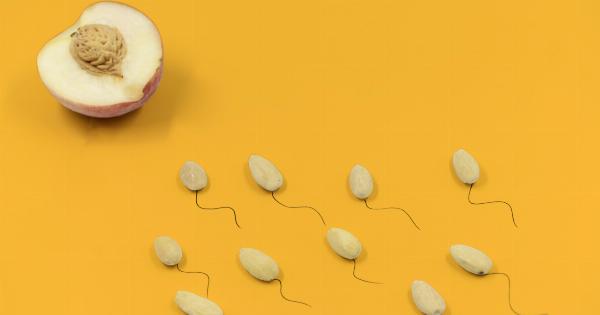Human reproduction is a complex process that involves the successful fusion of a sperm and an egg to form a new life. Sperm, the male reproductive cell, plays a vital role in this process.
In this article, we delve into the fascinating world of sperm and explore the science behind its formation, composition, and journey towards fertilization.
Sperm Formation: A Marvel of Cellular Differentiation
Sperm formation, also known as spermatogenesis, starts within the testicles, where millions of tiny seminiferous tubules house the process. It begins during puberty and continues throughout a man’s life.
The entire process takes around 64 to 72 days.
A Snapshot of Sperm Anatomy
Sperm cells are the smallest in the human body, measuring about 50 micrometers in length. They consist of a head, a midpiece, and a tail, each serving a specific function:.
1. Head: Storage of Genetic Information
The head of a sperm cell predominantly contains the nucleus, which houses the genetic material necessary for fertilization.
It carries 23 chromosomes, each contributed by the father, making up half of the genetic blueprint required to create a unique individual.
2. Acrosome: Penetrating the Barriers
Located at the tip of the sperm’s head, the acrosome is a specialized structure that contains enzymes crucial for fertilization. These enzymes help the sperm penetrate the outer layers of the egg, allowing it to fuse and initiate fertilization.
3. Midpiece: Powerhouse of Energy
The midpiece of a sperm contains mitochondria, which provide the energy necessary for the journey towards the egg. This region is packed with adenosine triphosphate (ATP), the energy currency of cells, ensuring the sperm’s motility and survival.
4. Tail: Propelling the Sperm
The tail, also known as the flagellum, allows the sperm to move forward by whipping, undulating, and propelling itself toward the egg.
The beating motion of the tail propels the sperm at an impressive speed of around 1-4 millimeters per minute, given its size.
From the Male Reproductive System to Ejaculation
Sperm cells are produced in the testicles through a highly orchestrated process. However, they don’t gain their full fertilizing ability until they travel through the male reproductive ducts.
After spermatogenesis and maturation, sperm cells are stored in a long, coiled tube called the epididymis, located on the posterior side of each testicle. Here, the sperm undergo further maturation and gain the ability to move independently.
The next phase occurs during ejaculation. The sympathetic nervous system triggers the rhythmic contraction of the vas deferens, seminal vesicles, and prostate gland. These muscular contractions propel the sperm and other seminal fluids into the urethra.
The Components of Seminal Fluid
Sperm cells constitute only a small portion of the seminal fluid, with the majority originating from other male reproductive glands. Seminal fluid, also known as semen, provides the sperm with an optimal environment for survival and motility.
1. Seminal Vesicles: These glands contribute approximately 70% of the fluid volume in semen.
Their secretions contain fructose, prostaglandins, and proteins, which act as an energy source for the sperm and provide protection against the acidic environment of the female reproductive tract.
2. Prostate Gland: The prostate gland contributes around 25% of the seminal fluid volume. It secretes a milky fluid containing enzymes, citrate, zinc, and acid phosphatase.
This fluid helps activate and nourish the sperm, increasing their chances of successful fertilization.
3.
Bulbourethral Glands: These small glands, also called Cowper’s glands, produce a clear, slippery fluid that lubricates the urethra and neutralizes any residual urine present, enhancing the sperm’s motility and protection during ejaculation.
The Journey Towards the Egg: Navigating a Challenging Terrain
Once the sperm is released into the female reproductive system, it faces numerous challenges on its path to fertilization.
For successful conception to occur, the sperm must travel through the cervix, navigate the uterus, and finally reach the fallopian tubes where the egg awaits.
Due to the severe acidity in the vaginal environment, which could be detrimental to the sperm’s survival, seminal fluid helps neutralize the acids.
The sperm then undergo a process called capacitation, which alters their outer membrane allowing them to navigate more effectively.
As the sperm continues its journey through the cervix, muscular contractions within the uterus and the action of cilia help propel and further guide the sperm towards the fallopian tubes.
It’s estimated that only a few hundred sperm cells out of millions survive this arduous journey.
Upon reaching the fallopian tubes, the sperm encounters the egg waiting to be fertilized. The acrosome on the sperm’s head releases enzymes that help it penetrate the egg’s protective layers.
Once a single sperm successfully enters the egg, fertilization occurs, resulting in the formation of a zygote.
Factors Affecting Sperm Health and Fertility
Sperm health can significantly impact fertility. Several factors can influence the quality, quantity, and motility of sperm:.
1. Lifestyle Factors: Habits such as smoking, excessive alcohol consumption, drug use, and a sedentary lifestyle can all negatively affect sperm health.
2. Age: As men age, the quality and quantity of sperm tend to decrease, making conception more challenging.
3. Environmental Factors: Exposure to certain chemicals, heavy metals, radiation, and pesticides can harm sperm production and function.
4. Health Conditions: Certain medical conditions, including infections, hormonal imbalances, varicoceles, and genetic disorders, can lead to male infertility.
Conclusion: Unraveling the Science Behind Sperm
Sperm, with its remarkable journey from production to fertilization, represents the essence of human reproduction.
Understanding the intricate biology behind spermatogenesis, the composition of seminal fluid, and the challenges sperm face during their arduous trek towards the egg helps shed light on the complex mechanisms at play when it comes to fertility.
By delving into the science behind sperm, we gain a greater appreciation for the marvels of reproduction and the vital role sperm plays in the continuation of life.



























